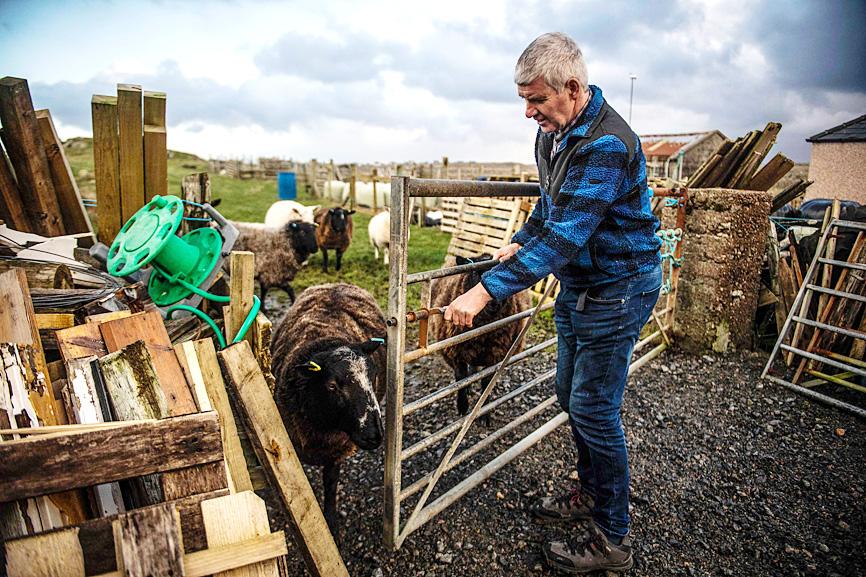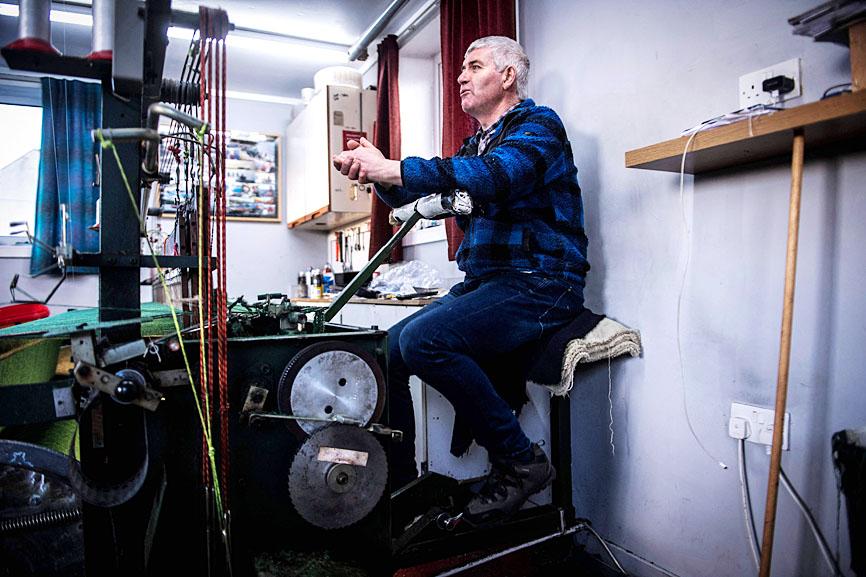In the cluttered workshop of his home off the coast of northwest Scotland, Ian Mackay patiently weaves a bright green wool, surrounded by bags of fabric, spools and tools. He makes a steady clatter as he pedals his machine in the shed of his croft on the village of South Shawbost on the Isle of Lewis, watching closely for any defects.
“It’s handwoven ... or rather foot-woven,” the 51-year-old weaver joked.
Mackay spins wool for 10 hours a day, resting only on Sundays, when most shops and services are shut on the religiously conservative islands.

Photo: AFP
Once complete, his handiwork — authentic Harris tweed — could be shipped to the other side of the world, as the rough woolen fabric becomes more popular than ever.
Long associated with the windswept Scottish islands, the textile’s ecological and sustainable properties have inspired designers to be more environmentally friendly.
“It doesn’t really matter how bad the weather is outside if you are weaving,” Mackay said as an icy wind whipped across the ocher-colored moor where sheep were grazing.

Photo: AFP
“There’s no point in being really fast, doing mistakes. You are better doing slow, quality work,” he said.
Such is its status, Harris tweed, traditionally made from 100 percent pure virgin — unrecycled — sheep’s wool, is the only fabric protected by an act of parliament.
The Harris Tweed Act 1993 stipulates that it “has been handwoven by the islanders at their homes in the Outer Hebrides, finished in the Outer Hebrides, and made from pure virgin wool dyed and spun in the Outer Hebrides.”
A distinctive Orb stamp globe with a cross on top certifies the fabric’s origin and authenticity.
Harris tweed, mostly woven with a plain weave, twill or herringbone structure, was originally associated with Britain’s aristocracy and gentlemen farmers.
Jackets and plus-fours made from the durable fabric that can withstand harsh climates were a must for traditionally outdoor upper-class pursuits such as hunting and fishing.
However, British designer Vivienne Westwood turned that image on its head by integrating it into her punk wardrobe in a subversion of culture and tradition.
Now other major brands, including Chanel, Christian Dior SE, Yves Saint Laurent and Hermes International SA, are making it a key element of their collections.
“Recently we have been working extensively with Polo Ralph Lauren in the USA,” Harris Tweed Hebrides sales director Margaret Ann Macleod said.
Seventy people work at the company’s lakeside factory, where the wool is dyed and spun, then sent to about 120 home weavers, where skills have been passed down for generations.
Once woven, it is returned to the factory 29km from Lewis’ main town of Stornoway to be washed, dried and finished in Shawbost Mill.
One-third of the Shawbost factory’s output goes to the UK, while two-thirds is exported to all corners of the world.
“We export extensively to France, Germany, Italy and a lot of other countries in Europe,” Macleod said. “We also have a big export business in South Korea, Japan and the USA, and increasingly China has become a new export market for us as well.”
In total, about 160 home weavers live in the Outer Hebrides, working hand-in-hand with three factories that produce a total of 1.5 million meters of the fabric every year.
Tweed, immortalized by Mr Toad, one of the main characters in Kenneth Grahame’s 1908 classic novel The Wind in the Willows, is used to make jackets, trousers and coats, but also shoes, handbags, armchairs and even teddy bears.
Fifteen years ago, sportswear brand Nike Inc chose Harris tweed for a collection of trainers — a huge publicity coup for the Hebridean craftsmen.
More recently, the public has rediscovered the fabric in its dozens of different patterns and shades through popular television series.
From the aristocrats of Downton Abbey to the gangsters of Peaky Blinders and the royal family in The Crown, virtually everyone wears tweed.
“We start with about 60 colors and we blend each of these colors to create over 180 different yarn shades and they would reflect the landscape and the seascape of the Outer Hebrides — the rich browns are the tones of the moorland, the blue of the Atlantic Ocean,” Macleod said.
“Young designers are coming and are looking for the colors. They are looking for authenticity, the fact that we are hand-weaving [and] creating our own yarns is really important to them,” she said. “They want to capture a little bit of the island, of the Outer Hebrides in their creations as well.”

To many, Tatu City on the outskirts of Nairobi looks like a success. The first city entirely built by a private company to be operational in east Africa, with about 25,000 people living and working there, it accounts for about two-thirds of all foreign investment in Kenya. Its low-tax status has attracted more than 100 businesses including Heineken, coffee brand Dormans, and the biggest call-center and cold-chain transport firms in the region. However, to some local politicians, Tatu City has looked more like a target for extortion. A parade of governors have demanded land worth millions of dollars in exchange

An Indonesian animated movie is smashing regional box office records and could be set for wider success as it prepares to open beyond the Southeast Asian archipelago’s silver screens. Jumbo — a film based on the adventures of main character, Don, a large orphaned Indonesian boy facing bullying at school — last month became the highest-grossing Southeast Asian animated film, raking in more than US$8 million. Released at the end of March to coincide with the Eid holidays after the Islamic fasting month of Ramadan, the movie has hit 8 million ticket sales, the third-highest in Indonesian cinema history, Film

Taiwan Semiconductor Manufacturing Co’s (TSMC, 台積電) revenue jumped 48 percent last month, underscoring how electronics firms scrambled to acquire essential components before global tariffs took effect. The main chipmaker for Apple Inc and Nvidia Corp reported monthly sales of NT$349.6 billion (US$11.6 billion). That compares with the average analysts’ estimate for a 38 percent rise in second-quarter revenue. US President Donald Trump’s trade war is prompting economists to retool GDP forecasts worldwide, casting doubt over the outlook for everything from iPhone demand to computing and datacenter construction. However, TSMC — a barometer for global tech spending given its central role in the

Alchip Technologies Ltd (世芯), an application-specific integrated circuit (ASIC) designer specializing in server chips, expects revenue to decline this year due to sagging demand for 5-nanometer artificial intelligence (AI) chips from a North America-based major customer, a company executive said yesterday. That would be the first contraction in revenue for Alchip as it has been enjoying strong revenue growth over the past few years, benefiting from cloud-service providers’ moves to reduce dependence on Nvidia Corp’s expensive AI chips by building their own AI accelerator by outsourcing chip design. The 5-nanometer chip was supposed to be a new growth engine as the lifecycle